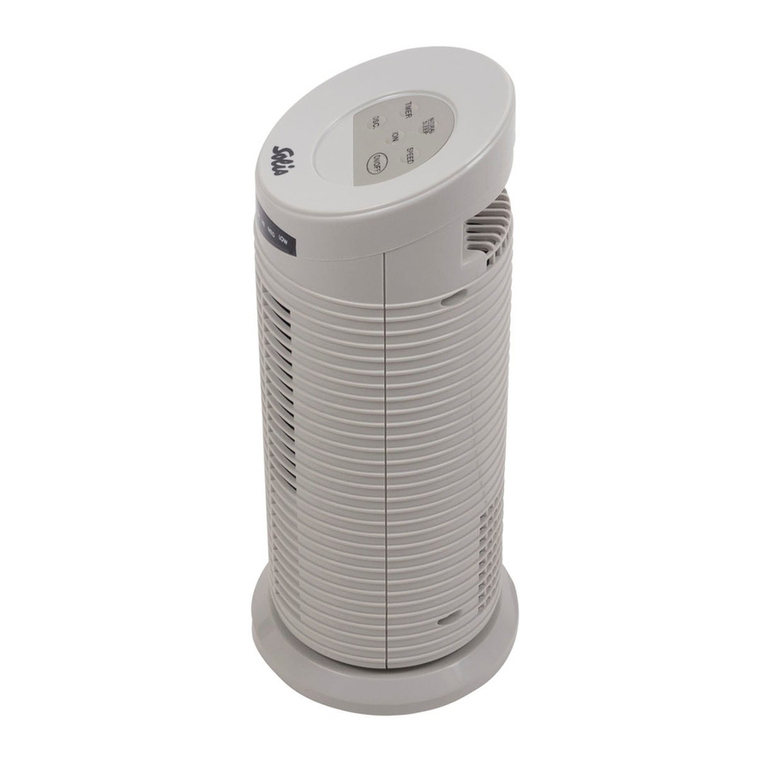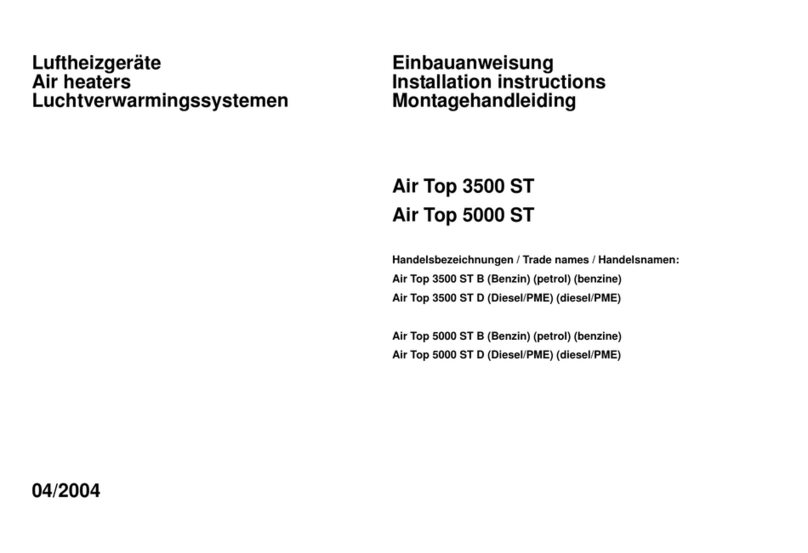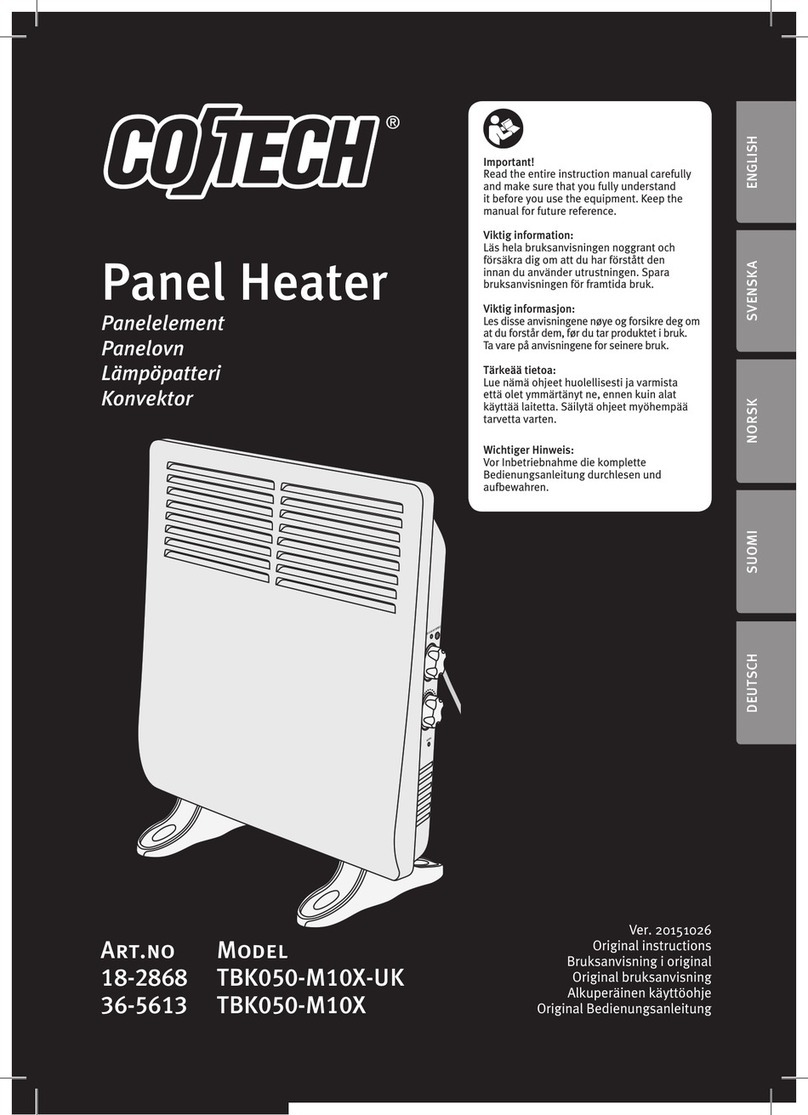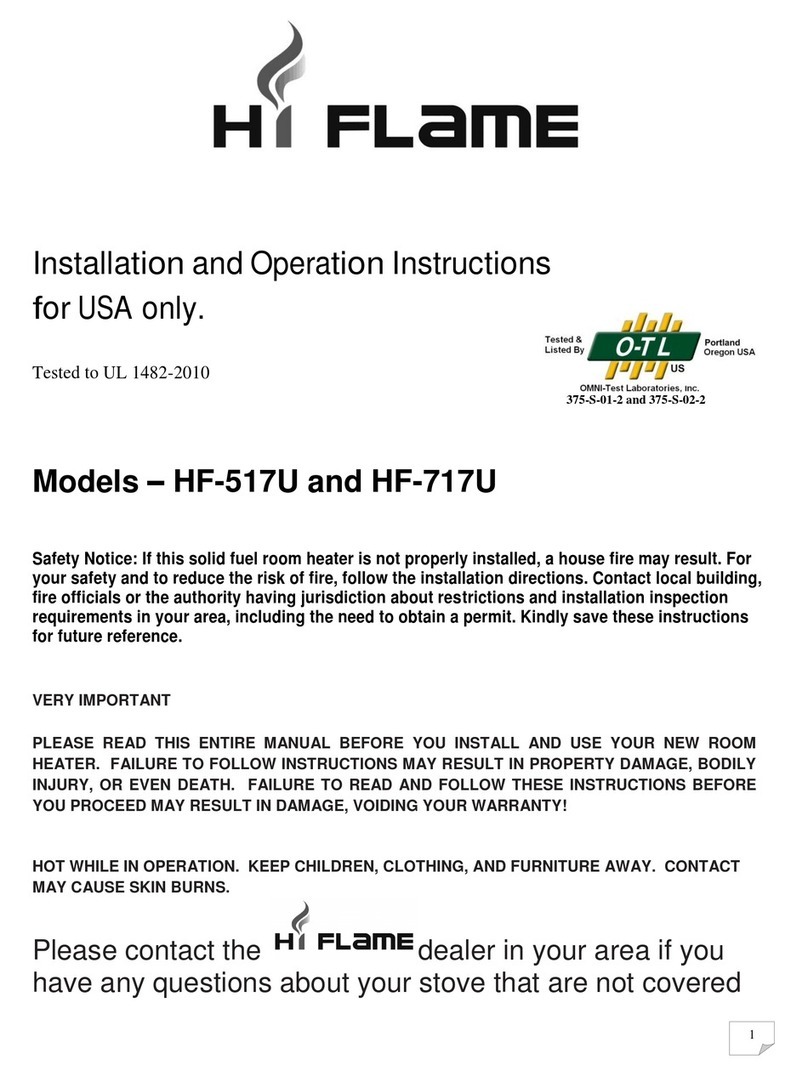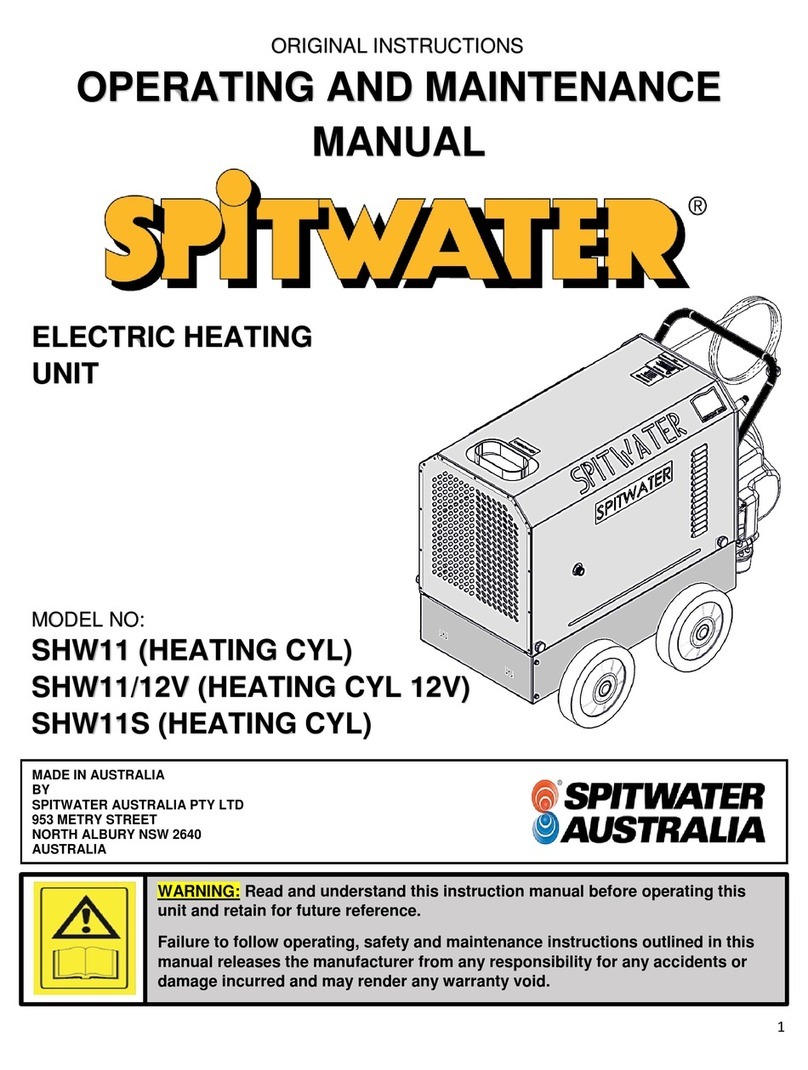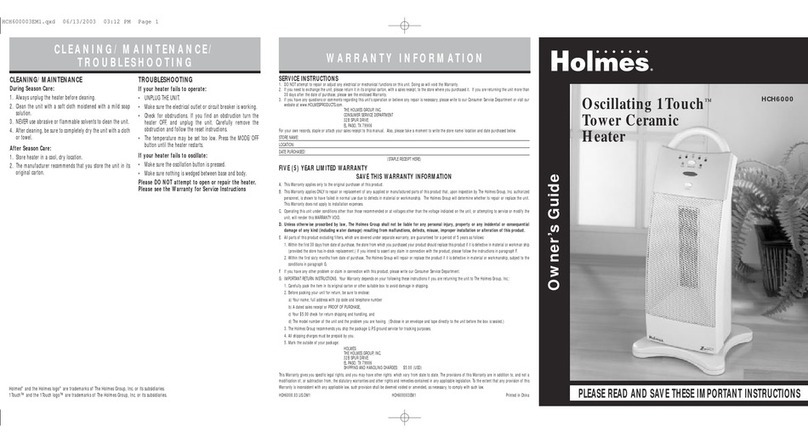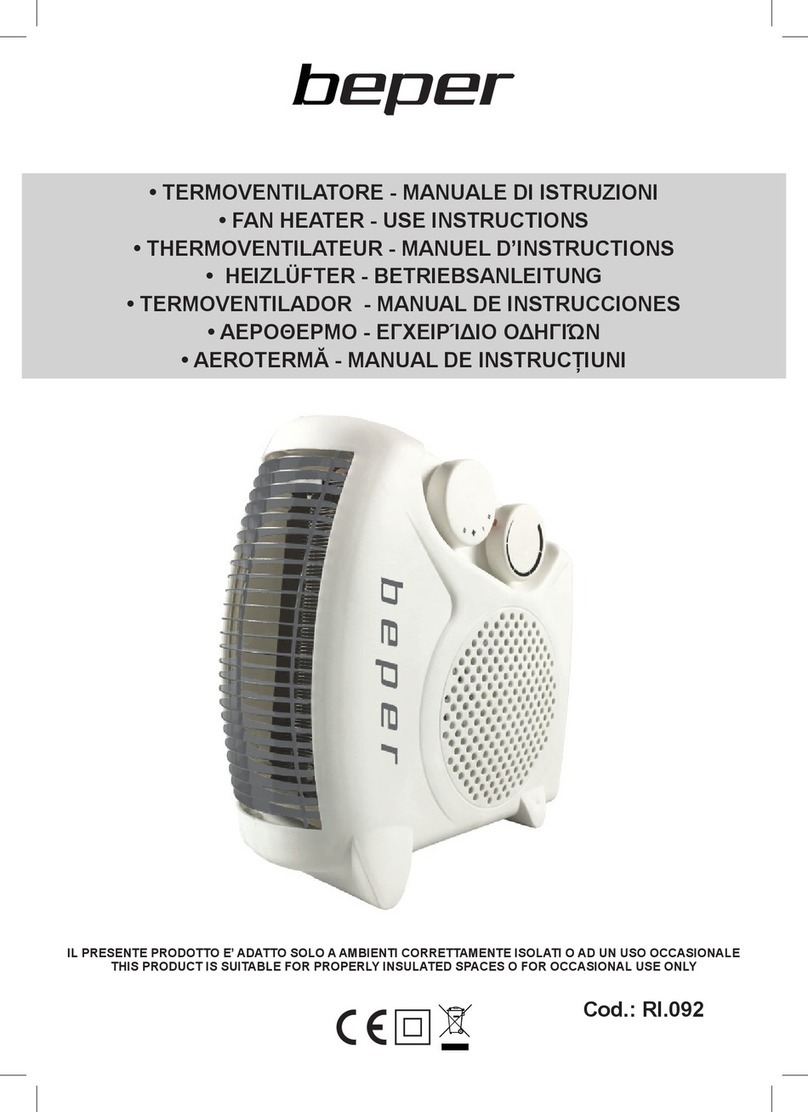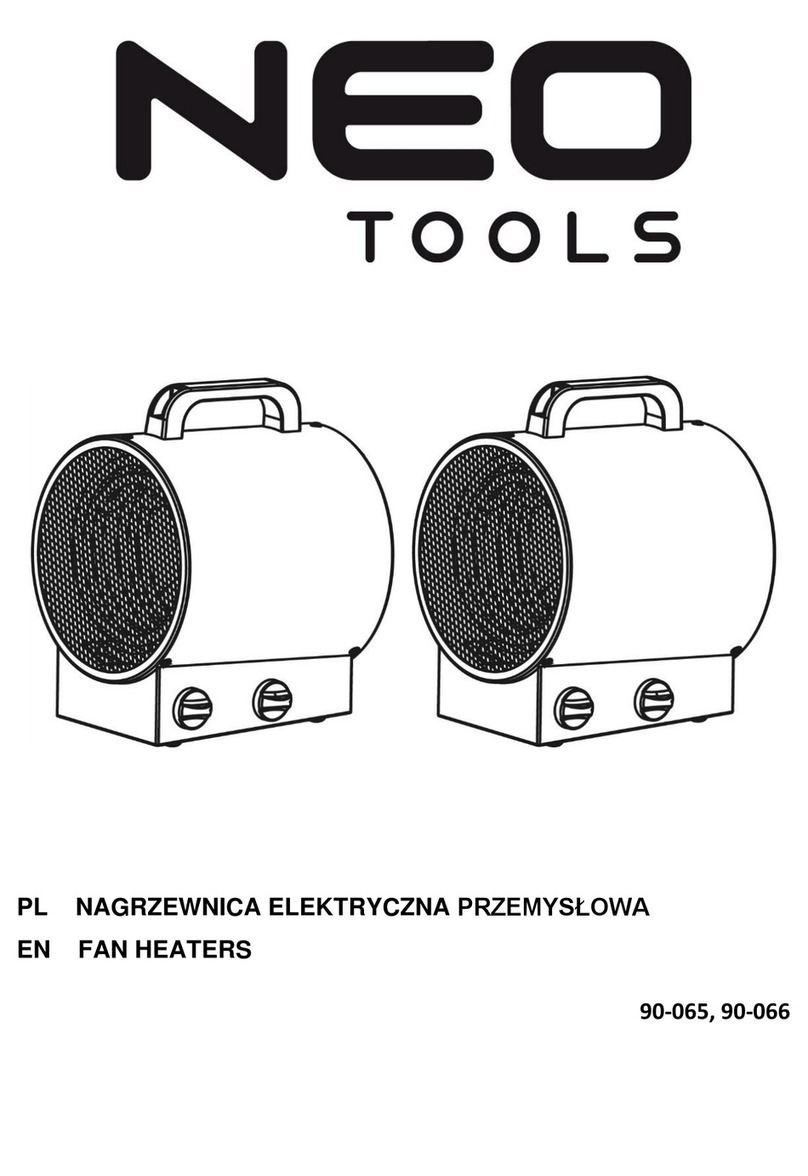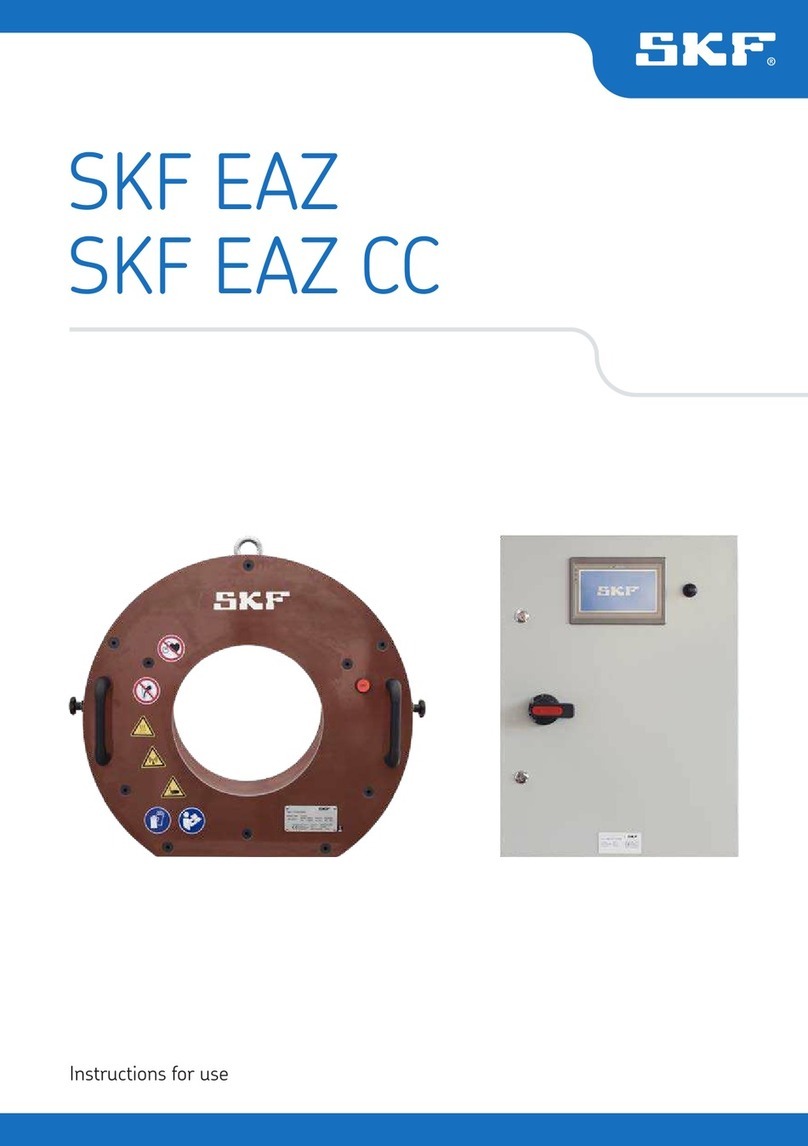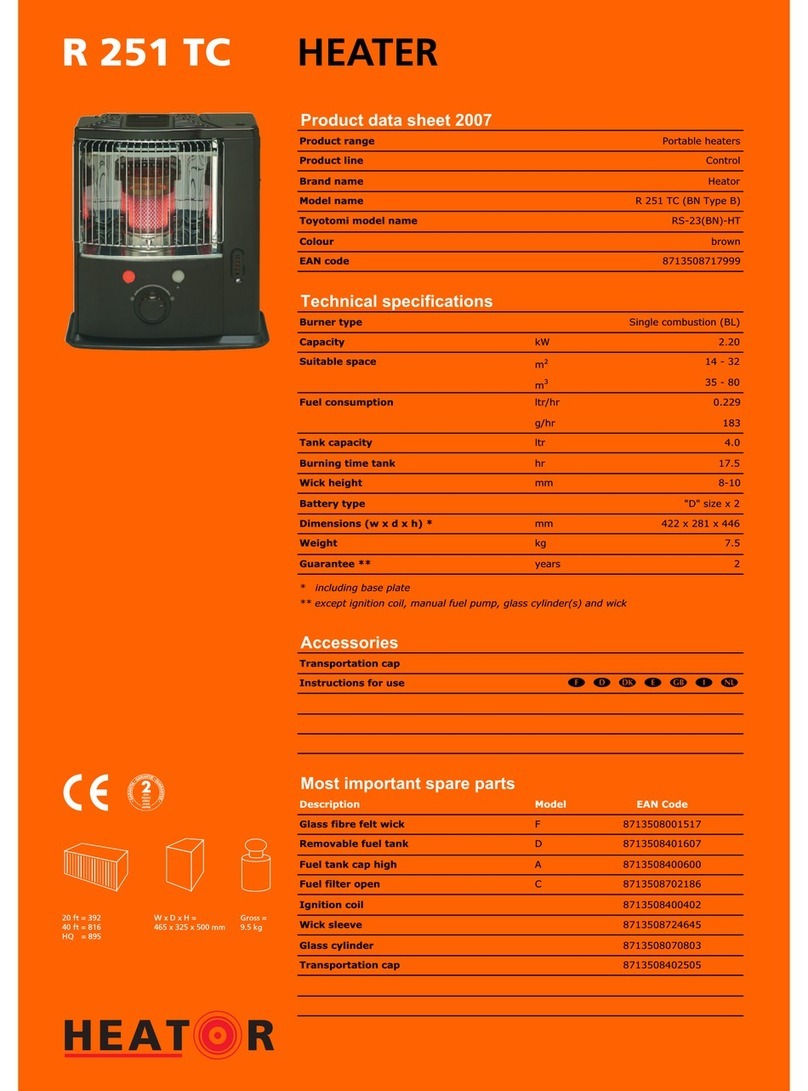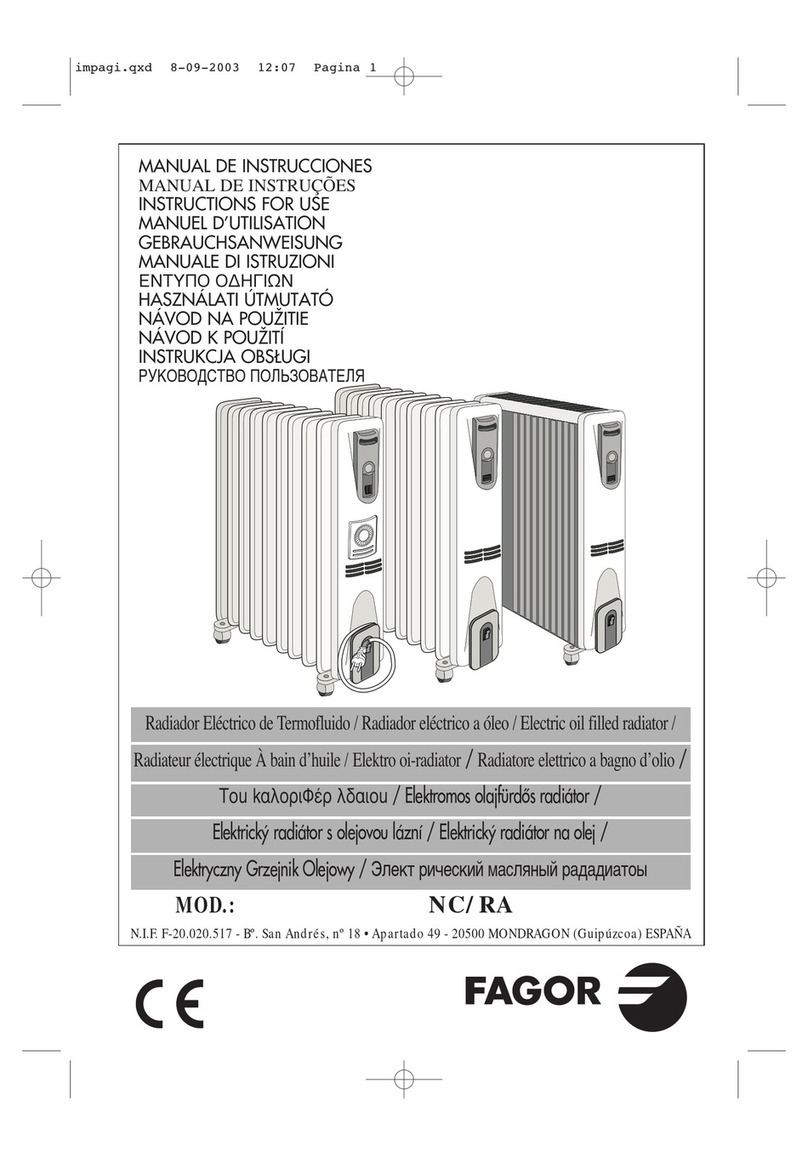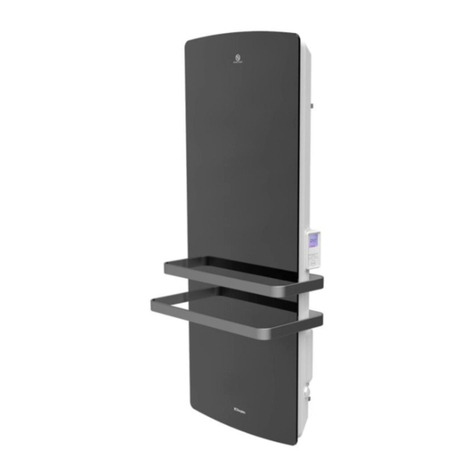Sure Flame IX4 User manual

Model No. IX4
Indirect Construction Heater
Radiateur de construction indirecte
400,000 Btu/h
Retain these instructions for future reference
Veuillez garder ce manuel comme référence ultérieure
Sure Flame Products
A Division of Haul-All Equipment
4115 - 18 Avenue North
Lethbridge, Alberta T1H 5G1
www.sureame.ca
Operation and Maintenance Manual
WARNING
Read and follow all installation, and
operating instructions before rst use of this
product
P/N 974-12096
Rev 1.00 Dec 21, 2023
Manuel d’installation et d’entretien
AVERTISSEMENT
Lisez et suivez toutes les installation et les
instructions de fonctionnement avant la
première utilisation de ce produit

2P/N 974-12096 Rev: 1.00
IX4 Operation & Service Manual
Fire, burn, inhalation, and explosion hazard. Keep solid combustibles, such as building
materials, paper or cardboard, a safe distance away from the heater as recommended by the
instructions. Never use the heater in spaces which do or may contain volatile or airborne
combustibles, or products such as gasoline, solvents, paint thinner, dust particles or unknown
chemicals.
WARNING
Failure to comply with the precautions and instructions provided with this heater, can result in
death, serious bodily injury and property loss or damage from hazards of re, explosion, burn,
asphyxiation, carbon monoxide poisoning, and/or electrical shock.
Only persons who can understand and follow the instructions should use or service this heater.
If you need assistance or heater information such as an instruction manual, labels, etc. Contact
the manufacturer.
GENERAL HAZARD WARNING
Le non-respect des mises en garde et des instructions fournies avec ce radiateur peut entraîner la mort,
de graves blessures et des pertes matérielles ou des dommages à la propriété résultant d’un incendie,
d’une explosion, de brulures, d’asphyxie, d’empoisonnement au monoxyde de carbone et/ou d’un choc
électrique.
Seules les personnes aptes à comprendre et à suivre les instructions devraient se servir de ce radiateur
ou le réparer.
Si vous avez besoin d’aide ou d’informations concernant ce radiateur, soit une notice d’instructions,
une étiquette, etc., prière de communiquer avec le fabricant.
MISES EN GARDE GÉNÉRALES
Risque d’incendie, de brûlures, d’inhalation et d’explosion. Garder les combustibles solides, tels les
matériaux de construction, le papier et le carton, à bonne distance de ce radiateur, comme il est recom-
mandé dans les instructions. Ne jamais utiliser cet appareil dans des endroits qui contiennent ou pour-
raient contenir des combustibles volatiles ou en suspension dans l’air tels l’essence, les solvants, les
diluants pour peinture, les particules de poussières ou des produits chimiques inconnus.
AVERTISSEMENT
Ne pas utiliser dans une maison ou un véhicule de camping.
AVERTISSEMENT
Not for home or recreational vehicle use.
WARNING

3
IX4 Operation & Service Manual
P/N 974-12096 Rev: 1.00
Read this Warning First
This heater is designed and approved for use
as a construction heater under ANSI Z83.7/
CSA 2.14. The primary purpose of construction
heaters is to provide temporary heating of
buildings under construction, alteration, or
repair and to provide temporary emergency
heat. Properly used, the heater provides safe
economical heating. Since the products of
combustion are released, it is imperative that the
ue stack is extended outside of the enclosed
area when the heater is positioned indoors.
This heater is not designed as an Unvented
Gas Fired Room Heater under ANSI-Z21.11.2
and should not be used in the home. ANSI
A119.2(NFPA 501C) Recreational Vehicle
Standard prohibits the installation or storage of
LP-Gas containers even temporarily inside any
recreational vehicle. The standard also prohibits
the use of Unvented Heaters in such vehicles.
Installation must comply with local codes, or
in the absence of local codes,
with the National Fuel Gas Code ANSI Z223.1/
NFPA 54 and the Standard
for the Storage and Handling of Liquied
Petroleum Gases ANSI/NFPA 58.
Gas inspection authorities in Canada require
that the installation and maintenance of
heaters and accessories be accomplished by
qualied gas tters.
Installation must comply with local codes,
and with the Natural Gas and Propane
Installation Code CSA-B149.1.
We cannot anticipate every use which may be
made for our heaters.
CHECK WITH YOUR LOCAL FIRE SAFETY
AUTHORITY IF YOU HAVE QUESTIONS
ABOUT LOCAL REGULATIONS.
Other standards govern the use of fuel gases
and heat producing products in specic
applications. Your local authority can advise you
about these
Lire cet avertissement en premier
Le radiateur est conçu et approuvé aux ns
d’utilisation comme radiateur de construction
en conformité avec la norme ANSI Z83.7/CSA
2.14. La fonction principale des radiateurs
de construction est de fournir un chauffage
temporaire des bâtiments en construction,
modication ou restauration, et de fournir de la
chaleur en cas d’urgence. Correctement utilisé,
le chauffage fournit de la chaleur de façon sûre
et économique. Étant donné que les produits
de combustion sont rejetés, il est impératif que
le conduit d’évacuation mène à l’extérieur de
l’espace clos lorsque le radiateur se trouve à
l’intérieur.
Ce radiateur n’est pas conçu comme chauffage
au gaz sans ventilation pour pièce d’habitation
selon la norme ANSI-Z21.11.2 et ne doit pas être
utilisé à domicile. La norme ANSI A119.2 (NFPA
501C) concernant les véhicules de loisirs interdit
l’installation ou l’entreposage de bouteilles de
gaz LP/propane, même temporairement, à
l’intérieur des véhicules de loisirs. La norme
interdit également l’utilisation de chauffage sans
ventilation dans de tels véhicules.
L’installation doit être conforme aux codes
locaux, ou en l’absence des codes locaux, au
National Fuel Gas Code ANSI Z223.1/NFPA 54
et le Standard
for the Storage and Handling of Liquied
Petroleum Gases ANSI/NFPA 58.
Au canada, toutés les autorties d’inspection
des appareils à gaz exignt que l’installation
des appareils de chauffage et de leurs
accessres soit effectuée par des gaziers
qualiés.
L’installation doit être conforme au code CSA
B149.1 code d’installation du gaz naturel et
du propane.
Nous ne pouvons pas anticiper chaque
utilisation qui pourrait être faite de nos
radiateurs.
VÉRIFIEZ AUPRÈS DE VOTRE AUTORITÉ
LOCALE EN PRÉVENTION DES INCENDIES
SI VOUS AVEZ DES QUESTIONS SUR LES
RÉGLEMENTATIONS LOCALES.
D’autres normes régissent l’utilisation des
carburants gazeux et des produits générateurs
de chaleur dans des applications spéciques.
Votre autorité locale peut vous en informer.

4P/N 974-12096 Rev: 1.00
IX4 Operation & Service Manual
• Do not use this heater for heating human living quarters.
Use of direct-red heaters in the construction environment can result in
exposure to levels of CO, CO2, and NO2 considered to be hazardous to
health and potentially life threatening.
• Do not use in unventilated areas.
• Know the signs of CO and CO2 poisoning.
- Headaches, stinging eyes
- Dizziness, disorientation
- Difculty breathing, feels of being suffocated
• Proper ventilation air exchange (OSHA 29 CFR 1926.57 )to support combustion and
maintain acceptable air quality shall be provided in accordance with OSHA 29 CFR Part
1926.154, ANSI A10.10 Safety Requirements for Temporary and Portable Space Heating
Devices and Equipment used in the Construction Industry or the Natural Gas and Propane
Installation Codes CSA B149.1.
- Periodically monitor levels of CO, CO2 and NO2 existing at the
construction site - at the minimum at the start of the shift and after 4
hours
- Provide ventilation air exchange, either natural or mechanical,
as required to maintain acceptable indoor air quality
USA 8-Hr Time weighted average Canada 8-hr time weighted average
(OSHA 29 CFR 1926.55 App A) WorkSafe BC OHS Guidelines Part 5.1
and Ontario Workplaces Reg 833
CO 50 ppm 25 ppm
CO2 5000 ppm 5000 ppm
NO2 3 ppm (Reg 833)
USA - Ceiling Limit (Short Term Canada STEL (15 minutes Reg 833/1
Exposure Limit = 15 minutes) hour WSBC) WorkSafe BC OHS
Guidelines Part 5.1 and Ontario
Workplaces Reg 833
CO 100 ppm
CO2 15000 ppm(WSBC)
30000 ppm(Reg 833)
NO2 5 ppm 1.0 ppm(WorkSafeBC)
5.0 ppm (Reg 833)
• Ensure that the ow of combustion and ventilation air exchange cannot
become obstructed.
• As the building ’tightens up’during the construction phases ventilation
may need to be increased.
WARNING
Air Quality Hazard

5
IX4 Operation & Service Manual
P/N 974-12096 Rev: 1.00
■ Ne pas utiliser cet appareil pour chauffer des logements humains.
■ L’utilisation d’appareils à chauffage direct dans un environnement de construction peut
entraîner l’exposition à des niveaux de CO, de CO2, et de NO2 considérés nocifs pour la
santé et potentiellement mortels.
■ Ne pas utiliser dans les zones non ventilées.
■ Apprendre à reconnaître les signes d’intoxication au CO, et CO2.
- Maux de tête, yeux qui piquent.
- Vertiges, désorientation.
- Dif culté à respirer, sensation d’étouffement.
■ A n de soutenir la combustion et de maintenir une qualité d’air acceptable, un échangeur
d’air de ventilation approprié (OSHA 29 CFR 1926.57) doit être fourni conformément à la
provision OSHA 29 CFR partie 1926.154, de l’Administration de la sécurité et de
l’hygiène du travail des États-Unis (OSHA), à la norme ANSI A10.10, Exigences relatives
aux appareils et appareils de chauffage des locaux temporaires et portatifs utilisés dans
l’industrie de la construction de l’Association américaine de normalisation ou aux codes
d’installation du gaz naturel et du propane CSA B149.1 de l’Association canadienne de
normalisation.
- Surveiller périodiquement les niveaux de CO, de CO2 et de NO2 sur le chantier de
construction, au moins au début du quart de travail et après 4 heures.
- Le cas échéant, assurer un échange d’air de ventilation, naturel ou mécanique, an
de maintenir une qualité d’air intérieur acceptable.
É.-U. 8 heures. Moyenne pondérée dans le temps Canada 8 heures Moyenne
pondérée dans le temps
(OSHA 29 CFR 1926.55 App A) Directives sur la santé et la sécurité
au travail de WorkSafe BC, section
5.1 et la Réglementation 833 de
l’Ontario relative aux lieux de travail
CO 50 ppm 25 ppm
CO2 5 000 ppm 5 000 ppm
NO2 3 ppm (Rég. 833)
É.-U.– Hauteur limite du plafond Canada STEL (15 minutes Rég. 833/1 h
(Limite d’exposition à court terme = 15
minutes) WSBC) Directives sur la santé et
la sécurité au travail de WorkSafe BC,
section 5.1 et Réglementation sur les lieux
de travail de l’Ontario, 833
CO 100 ppm
CO2 15 000 ppm (WSBC)
30 000 ppm (Rég. 833)
NO2 5 ppm 1,0 ppm (WorkSafeBC)
5,0 ppm (Rég. 833)
■ Assurez-vous que le débit d’échange d’air de combustion et de ventilation ne peut pas être
obstrué.
■ La ventilation peut devoir être augmentée au fur et à mesure que le bâtiment se « resserre »
pendant les phases de construction.
AVERTISSEMENT
Danger lié à la qualité de l’air

6P/N 974-12096 Rev: 1.00
IX4 Operation & Service Manual
Table of Contents
Specications..................................................................................... 7
Installation.......................................................................................... 8
Operating Instructions........................................................................ 12
Maintenance ...................................................................................... 18
Troubleshooting Chart ....................................................................... 21
Wiring Diagrams ................................................................................ 30
Parts Diagrams .................................................................................. 32
Table des matières
Spécications..................................................................................... 7
Installation.......................................................................................... 8
Mode d’emploi.................................................................................... 12
Entretien............................................................................................. 18
Tableau de dépannage ...................................................................... 21
Schémas de câblage ......................................................................... 30
Schémas de pièces............................................................................ 32

7
IX4 Operation & Service Manual
P/N 974-12096 Rev: 1.00
SPECIFICATIONS
Model No. IX4
Capacity / Capacite: 400,000 Btu/h (117 kW)
Gas/Gaz: Natural or Propane
Inlet Pressure* / Pression d’arrive*: Max 14” WC (3.45 kPa)
Min 8” WC (2.00 kPa)
Manifold Pressure / Pression du distributeur Natural Gas 3.5” WC (0.87 kPa)
Propane 1.8” WC (0.45 kPa)
Orice Size / Calibre de l’injecteur: 0.436”
Electrical Rating / Puissance Electrique: 120 Volts, 12 A, 1 Ph, 60 Hz
Minimum Temperature / température minimale: -40°C (-40°F)
Duct Diameter / diamètre du conduit: 16” or 2 x 12”
Maximum Duct Length /
Longueur maximale du conduit: 100’ (30.5 m)**
Venting Category I
Fuel Consumption / consommation de carburant Natural Gas 400 ft³/hr
Propane 159 ft³/hr
Certication ANSI Z83.7, CSA 2.14
* Minimum inlet pressure is for purpose of input adjustment.
* La pression minimum d’arrivée est en vue de l’ajustement de l’alimentation.
** Smooth metal duct / conduit métallique lisse
Altude Natural Gas Propane
0' - 2000' 3.5” (870 Pa) 1.8” (450 Pa)
2500' 3.4” (850 Pa) 1.7” (420 Pa)
3000' 3.3” (820 Pa) 1.7” (410 Pa)
3500' 3.3” (810 Pa) 1.6” (400 Pa)
4000' 3.2” (800 Pa) 1.6” (390 Pa)
4500' 3.1” (770 Pa) 1.5” (370 Pa)
Max. Manifold Pressure Altitude Correction Table

8P/N 974-12096 Rev: 1.00
IX4 Operation & Service Manual
Installation
The Sure Flame Model IX4 is an indirect-
red gas heater intended to be used
primarily for the temporary heating of
buildings under construction, alteration or
repair. Since the products of combustion are
released, it is imperative that the ue stack
is extended outside of the enclosed area
when the heater is positioned indoors. The
ow of supply air and exhaust gasses must
not be obstructed in any manner.
The equipment shall be installed in
accordance with the National Fuel Code,
ANSI 223.1/NFPA 54, and/or the Natural
Gas and Propane Installation Code CSA
B149.1, and applicable local regulations,
which should be carefully followed in all
cases. Authorities having jurisdiction should
be consulted before installations are made.
The heater shall be used in a horizontal
position on a rm, non-combustible surface.
The electrical grounding of the appliance
shall be in compliance with National
Electrical Code, ANSI/NFPA 70, or the CSA
C22.1, Canadian Electrical Code, Part I
Warning: The installation and maintenance
of the heater must be accomplished by a
qualied service person. The heater should
be inspected before each use and at least
annually.
Warning: Do not use this heater in a
space where gasoline of other liquids with
ammable vapours are stored or used.
Le modèle Sure Flame IX est un radiateur
au gaz à combustion indirecte prévu pour
être utilisé principalement pour réchauffer
temporairement un bâtiment en cours de
construction, modication ou restauration.
Étant donné que les produits de combustion
sont rejetés, il est impératif que le conduit
d’évacuation mène à l’extérieur de l’espace
clos lorsque le radiateur se trouve à
l’intérieur. L’écoulement d’air d’admission et
des gaz de combustion ne doit en aucune
façon être obstrué.
L’équipement doit être installé
conformément à la National Fuel
Code, ANSI 223.1/NFPA 54, et/ou la
code d’installation du gaz naturel et du
propane CSA B149.1, et aux règlements
locaux applicables, qui devraient être
respectés dans tous les cas. Les autorités
compétentes devraient être consultées
avant de procéder à l’installation.
Le radiateur devrait être utilisé
horizontalement sur une surface non
combustible ferme.
La mise électrique à la terre de l’appareil se
fera conformément au National Electrical
Code, ANSI/NFPA 70, ou le CSA C22.1,
Code canadien de l’électricité, 1re partie.
Avertissement : Installation et
maintenance du radiateur doivent être
effectuées par un agent de service
qualié. Le radiateur doit être inspecté
avant chaque utilisation, et au moins une
fois par an.
Avertissement : Ne pas utiliser
le radiateur dans un endroit où on
entrepose ou utilise de l’essence
ou d’autres liquides émanant des
vapeurs inammables.
Installation

9
IX4 Operation & Service Manual
P/N 974-12096 Rev: 1.00
Clearances
Clearance required for combustibles:
Outlet: 10 ft (3 m)
Sides: 2 ft (0.6 m)
Top: 3 ft (0.9 m)
Flue: 18” (45 cm)
Minimum clearance required to LP Gas
containers:
Outlet: 20 ft (6.1 m)
Top & Sides: 10 ft (3.0 m)
Position heater properly on a horizontal sur-
face before use.
The hose assembly shall be protected from
trafc, building materials and contact with hot
surfaces both during use and while in stor-
age. For use with or without ductwork. Only
ductwork supplied by the manufacturer shall
be used with this heater. For either indoor or
outdoor use. Adequate ventilation must be
provided. This heater is for operation at a
temperature rise from 80°C to 120°C (145°F
to 215°F).
All gas inspection authorities in Canada
require that the installation and maintenance
of heaters and accessories shall be accom-
plished by qualied gas tters.
Installation must comply with the Natural Gas
and Propane Installation Code, CSA B149.1.
Ducting
The IX4 can be ducted on both the inlet and
outlet. The inlet duct can be up to 50’ of
smooth 16” metal duct. The heater requires
some fresh air when recirculating. Do not
block the inlet louvers. The outlet duct shall
be of a material able to withstand tempera-
tures of up to 300°F. Total outlet duct length
may be up to 100’ of straight, smooth, 16”
metal duct. The maximum length of exible
ducts depends on the type of duct, number of
bends, and ambient temperature. It is typically
about 50’. Excessive restriction will reduce
the the allowable length and may result in
cycling of the burner. After setting up the
ductwork, conrm that the heater will run for
at least 20 minutes without the burner cycling.
If it cycles, reduce the duct restrictions so that
the heater can run without cycling.
Dégagements
Espace dégagé requis pour les combustibles:
Sortie: 10 pi (3m)
Cotes: 2 pi (0.6 m)
Combustion: 18 po (45 cm)
Dessus: 0.9 m
Espace minimum requis pour les contenants de
Gaz PL
Sortie: 20 pi (6.1 m)
Dessus et Cotes: 10 pi (3.0 m)
Placez le radiateur de façon appropriée, sur une
surface horizontale, avant de l’utiliser.
L’ensemble de exibles devra être protégé de
la circulation, des matériaux de construction et
du contact avec des surfaces chaudes durant
l’utilisation et durant l’entreposage. Pour utilisa-
tion avec ou sans réseau de gaines. Seulement
réseau de gaines fourni par le fabricant sera uti-
lisé avec cet radiateur. Pour utilisation à l’intérieur
ou à l’extérieur. La ventilation doit être adéquate.
Cet aérotherme fonctionne a une élévation de
température de 80°C a 120°C (145°F a 215°F)
Au canada, toutés les autorties d’inspection des
appareils à gaz exignt que l’installation des ap-
pareils de chauffage et de leurs accessres soit
effectuée par des gaziers qualiés.
L’installation doit être conforme au code CSA
B149.1 code d’installation du gaz naturel et du
propane.
Conduits
Le radiateur IX4 peut être canalisé à l’orice
d’entrée et de sortie. La canalisation d’entrée
peut atteindre jusqu’à 50 pieds de conduits en
métal lisse de 16 po. Le chauffage a besoin d’un
peu d’air frais lors de la recirculation. Ne pas
bloquer les grilles d’entrée d’air. La canalisation
de sortie sera fabriquée d’un matériau pouvant
résister à des températures allant jusqu’à 300
°F. La longueur totale du conduit de sortie peut
atteindre 100 pieds de conduit métallique droit et
lisse de 16 pouces. La longueur maximale des
conduits exibles dépend du type de conduit, du
nombre de coudes et de la température ambi-
ante. Il s’agit généralement d’environ 50’. Une
restriction excessive réduira la longueur autori-
sée et pourrait entraîner un cycle du brûleur.
Après avoir installé les conduits, conrmez que
le chauffage fonctionnera pendant au moins 20
minutes sans que le brûleur n’effectue de cy-
cle. Si le brûleur effectue de cycle, réduisez les
restrictions des conduits an que le chauffage
puisse fonctionner sans cycle.

10 P/N 974-12096 Rev: 1.00
IX4 Operation & Service Manual
Venting
This equipment requires Category I venting
to the exterior. The vent connector should
be designed for a negative pressure and be
constructed of materials having corrosion
resistance and durability to heat at least
equivalent to that of No. 26 GSG galvanized
steel.
Venting must comply with the Natural Gas and
Propane Installation Code CSA B149.1, as
well as other local regulations that may apply.
Flue Diameter 6
Min. vertical height 2’
Max. lateral length* 15’
Max. # of added elbows** 2
*Lateral lengths must have a minimum 10%
rise.
** A minimum vertical length of 2’ is required
before the rst elbow and after the last elbow.
Consult the manufacturer for additional
venting options.
Rated ue gas temperature 480°F (250°C)
Rated vent pressure - Negative
Category I
Gas Connections
Ensure the correct regulator is used to supply
the heater with maximum inlet pressure of
1/2 psi (3.45 kPa). Excessive pressure will
damage components and void the warranty.
Visually inspect the fuel supply hose
assembly. Ensure that it is protected from
trafc, building materials, and contact with
hot surfaces. Replace if there is evidence of
excessive wear or abrasion.
After installation, check for gas leaks by
applying a soapy solution at each piping and
hose assembly connection.
Ventilation
Cet équipement exige une ventilation vers
l’extérieur de Catégorie I. Le raccord d’évent
devrait être conçu pour une pression négative
et construit de matériaux ayant une résistance
à la corrosion et une durabilité à la chaleur
équivalant au moins à l’acier galvanisé no 26
GSG.
La ventilation doit se conformer à la Norme
concernant les Installations au gaz naturel et
au propane CSA B149.1, ainsi qu’aux autres
règlements locaux qui peuvent s’appliquer.
Conduit d’évacuation 6 po
Hauteur min. verticale 2 pi
Longueur max. latérale* 15 pi
Nombre max. de coudes** 2
*Les longueurs latérales doivent avoir une
inclinaison d’au moins 10 %.
**Une longueur verticale d’au moins 2 pieds
est requise avant le premier coude et après le
dernier coude.
Consulter le fabricant pour des options de
ventilation supplémentaires.
Temperature nominale du gaz de combustion
480°F (250°C)
Pression nominale de l’event - Négative
Catégorie I
Raccords au gaz
S’assurer que le régulateur approprié est utilisé
pour fournir la pression d’admission maximale
de 1/2 psi au radiateur. Une pression excessive
endommagera les pièces et annulera la
garantie.
Inspecter visuellement l’ensemble du tuyau
d’alimentation. S’assurer qu’il est protégé de
la circulation, des matériaux de construction
et du contact avec des surfaces chaudes.
Le remplacer, s’il y a des signes d’usure ou
d’abrasion excessive.
Après l’installation, vérier s’il ya des fuites de
gaz en appliquant une solution savonneuse à
chaque raccord de la canalisation.

11
IX4 Operation & Service Manual
P/N 974-12096 Rev: 1.00
INSTALLATION USING A PROPANE SUPPLY TANK
1 When installing the heater for use with propane gas, set the gas selector valve to “Propane”
and lock in position.
2 Arrange the propane supply system to provide for vapour withdrawal from the operating
container. Supplying liquid propane to the heater is dangerous and will damage the
components. Another regulator must be installed on the heater to reduce the pressure
from this regulator to a maximum inlet pressure of 1/2 psi (3.45 kPa).
3 Ensure that for the surrounding temperature the size and capacity of the propane supply
container is adequate to provide the rated Btu/h input to the heater.
4 Turn off the propane supply valve at the container when the heater is not in use.
5 The installation must conform with local codes, or in the absence of local codes, with the
Standard for the Storage and Handling of Liquedied Petroleum Gases, ANSI/NFPA 58 or
the Natural Gas and Propane Installation Code CSA-B149.1.
6 When the heater is to be stored indoors the propane container must be disconnected from
the heater and the container moved away and stored in accordance with the above national
standards.
INSTALLATION FOR NATURAL GAS APPLICATIONS
1 When installing the heater for use with natural gas, set the gas selector valve to the “Natural”
position.
2 A regulator must be installed on the heater to ensure that the pressure to the heater does
not exceed 1/2 psi inlet pressure.
3 The installation of this heater to a natural gas supply must conform with all applicable local
codes, or in the absence of local codes, with the National Fuel Gas Code ANSI Z223.1/
NFPA 54 or the Natural Gas and Propane Installation Code CSA-B149.1.

12 P/N 974-12096 Rev: 1.00
IX4 Operation & Service Manual
Start
1. Set GAS SELECTOR VALVE to gas being used (dual-fuel models).
NOTE: When using Propane Gas the Selector valve must be locked in position.
2. Ensure the ring valve (manual valve nearest the burner) is in the “ON” position.
3. Connect power. Use appropriate power supply as indicated by the ELECTRICAL
RATING information.
4. Open gas supply.
5. Select desired heat mode (see above).
6. Press the START button.
7. The status will change to “Ignition.” Burner fan will start up and heater will attempt to
ignite.
8. After ame is established, the status will change to “ON” with a ame symbol.
Stop
1. Press the STOP button.
2. Status will change to “OFF.”
3. Heater will go through shutdown phase. Burner will be in post purge for approximately
20 seconds. Main fan will shut down when heater has cooled down enough.
Warning: Do not stop the heater by turning off the main electrical switch. Heat
accumulated in the heater can damage burner or safety equipment.
Operating Instructions
NATURAL GAS PROPANE

13
IX4 Operation & Service Manual
P/N 974-12096 Rev: 1.00
Keypad and Display
MENU SELECT/SAVESTART STOP
Heater status
Heater Mode
Green/On Light
Start/Clear Error Button
Red/Error Light
Stop Button Menu/ Exit Menu Button
Select/Save Button
Display Screen
Down Arrow/Menu
Navigation Button
Up Arrow/Menu
Navigation Button
Membrane Keypad
When heater is rst plugged in and the power selector switched on, the screen rst displays
the logo “SURE FLAME,” then displays the heater model and software version currently
installed, and nally the Status/Mode/Run page.
Status
Status Description
OFF The heater goes to “OFF” when it is powered off. The heater also goes
to “OFF” when STOP button is pressed. Heater does not start on its own
when power is provided to unit.
Standby When the start button is pressed and the heater is set to work with thermo-
stat but there is no call for heat the heater will be in “Standby”. The modes
that require a thermostat are “HI/LO/OFF, HI/OFF, & LO/OFF”.
Ignition This status will always show when burner is ring up after a call for heat
through thermostat or “CONST HI”, “CONST LO” modes and “HI/LO.”
ON Burner is on and ame has been established.

14 P/N 974-12096 Rev: 1.00
IX4 Operation & Service Manual
Errors
Occasionally errors and warnings may be displayed on the screen. If more than one error
is triggered the arrow keys can be used to scroll between the errors and warnings. The top
right displays the current and total number of errors with the most recent being shown rst.
To reset the errors and warnings hold down the start button for 3 seconds. If the errors and
warnings do not reset then the underlying problem must be addressed rst. The error or
warning can then be successfully reset.
When errors are triggered the error is displayed, the heater will shut down and the red light
on the keypad will be turned on. When a warning is triggered it will display the message but
it will not impede the function of the heater.
Warning /Error Message Example:
MENU SELECT/SAVESTART STOP
WARNING 006 1/3
Critical Low
System Voltage
HOLD to RESET
Error/Warning Message
Error/Warning
Error/Warning no. (see table) Displaying Message 1 of 3
Reset Error/Warning
Instructions (hold
for 3 seconds)

15
IX4 Operation & Service Manual
P/N 974-12096 Rev: 1.00
Statistics
To access Statistics press the MENU button and scroll using the arrow keys to Statistics and
press SELECT/SAVE.
Page Descrition
1 PCB voltage in PCB system voltage
2 PCB system voltage Circulation blower hours
3 PCB software version Heater Serial Number
Menu
Menu Item Description
Heat Mode Allows the switching between different heat modes and fan only mode.
Statistics In this section the software version, heater serial number, voltage, ame rod
signal, burner and blower hours of function can be viewed.
Error log The past 50 errors are saved here and can be viewed.
Settings Date and time can be set and viewed here. Language can be set here.
To access the menu press the MENU button and scroll using the arrow keys. Press
SELECT/SAVE to select an option. Press MENU to back out of the menu.
Heat Modes
To access heat modes, press the MENU button and scroll using the arrow keys to Heat
Mode and press SELECT/SAVE.
Heater Mode Description
HI/OFF Heater runs between high re and off based on thermostat.
CNST ON/HI Heater runs on high re all the time and disregards thermostat.
Fan Only Circulation fan runs continuously. No heat.

16 P/N 974-12096 Rev: 1.00
IX4 Operation & Service Manual
Settings
To access Settings, press the MENU button and scroll using the arrow keys to Settings and
press SELECT/SAVE.
Setting Description
Units Choice between metric and imperial units (not applicable to this heater).
Date/Time Set date and time here.
Language Set Language here.
Set Date/Time
Access the settings menu. Scroll using the arrow keys to “Date/Time” and press the
SELECT/SAVE. To set the date or time hold the SELECT/SAVE until the month starts
blinks. To move from month to day or year press SELECT/SAVE until you reach the desired
position. Use the arrow keys to set the new value. Press SELECT/SAVE to move to the next
value to be changed. To save changes press and hold SELECT/SAVE until the seconds
start counting up again.
Error Log
To access the Error Log press the MENU button and scroll using the arrow keys to Error Log
and press SELECT/SAVE.
Scroll up and down using the arrow keys to view the error history from most recent to oldest.
To clear the error log press and hold the SELECT/SAVE till the rst line of the Error Log
reads “End of Error Log”.
Set Language
Access the settings menu. Scroll using the arrow keys to “Language” and press the
SELECT/SAVE.
Scroll up and down using the arrow keys to the desired language setting and press
SELECT/SAVE to set the new language. An asterisk * should appear next to the selected
language. Press MENU button twice to return to status page.

17
IX4 Operation & Service Manual
P/N 974-12096 Rev: 1.00
10 P/N 974-1185 Rev: 1.0
IX410 Operation & Service Manual
MAXIMUM BTU CONTENT (PROPANE)
The following table shows the maximum BTU's that a cylinder contains.
CAUTION:
In extremely cold weather it is impossible to completely empty a propane cylinder.
PRESSURE & FLOW EQUIVALENTS
1 Std. Atmosphere = 14.73 lb./sq. in. = 1.014 bar
1" Water Column (W.C.) = 0.58 oz./sq. in. = 2.49 millibar
11" Water Column = 0.4 lb./sq. in.= 27.39 millibar
1 lb./sq. in. (psig) = 27.71" W.C. = 0.0689 bar
1" Mercury = 0.49 psig = 33.86 millibar
1 Std. Cubic Ft./Hr. = 2,500 BTU/Hr. = 0.02832 cu. m/hr.
1 BTU/Hr. = 0.2931 Watts
LPG - PROPANE FUEL VAPORIZATION RATE
The following chart shows the amount of BTU's that various sizes of tanks will produce on the average at specific
temperaturesandregularatmosphericconditions.
* Frosting on the outside of the tank acts as an insulator, reducing the vaporization rate.
+40 F. +30 F. +20 F. +10 F. 0 F. -10 F -20 F. -30 F.
150 214,900 187,900 161,800 148,000 134,700 132,400 108,800 107,100
(600)
250 288,100 251,800 216,800 198,400 180,600 177,400 145,800 143,500
(1000)
500 478,800 418,600 360,400 329,700 300,100 294,800 242,300 238,600
(2000)
1000 852,800 745,600 641,900 587,200 534,500 525,400 431,600 425,000
(4000)
Tank Size
Gallons
(Pounds)
Maximum intermittent withdrawal rate (BTU/hr) without tank frosting*
if lowest outdoor temperature (average for 24 hours) reaches.
CYLINDERSIZE BTU CONTENT
100 pound 2,159,100
250 gallon USA 22,922,500
500 gallon USA 45,845,000
1000 gallon USA 91,690,000

18 P/N 974-12096 Rev: 1.00
IX4 Operation & Service Manual
Maintenance
Warning: Disconnect gas and electrical supplies before servicing.
Heater should be inspected before each use and at least annually by a qualied service person.
Weekly:
Gas Hose Check for cracks and damaged connectors
Air ow Remove any obstructions to air ow
Monthly:
Cords and Connectors Check for cracks, exposed wires, and dirt in electrical connectors
Physical Integrity Check for damage to body, louvers, and inlet screens that may obstruct
air ow and impact combustion quality
Start of Season:
Combustion Chamber Remove burner assembly
Clean inside of combustion chamber with a wire brush. Vacuum all ash
and soot from combustion chamber.
Inspect combustion chamber for any damage. Do not use a heater that
has a hole in the combustion chamber.
Burner Remove burner from burner assembly
Clean ame rod and igniter with solvent or emery cloth. Inspect for
cracked ceramic. Ensure they are properly centered in the burner
openings. Inspect wires for cracks or evidence of overheating
Ensure burner head screws are tight.
Ensure openings in orice plate (located inside the burner pipe) are not
blocked. Ensure gasket and door seal are in place and not damaged.
Electrical components Check all wiring for loose, cracked, or overheated wires and connectors.
Replace if necessary.
Ensure ground wires are properly connected.
Ensure control box seal is in place and not damaged.
Valve Train Verify that manifold pressure matches the specication label. Adjust
regulator pressure if necessary.
Inspect strainer and clean if necessary.
Using soapy water or gas leak detector, check all gas connections for
leaks.
Impellers Remove any dirt build-up on both burner and blower impellers.
Inspect impellers for loose or damaged ns.
Run heater and check for vibration.
Replace impellers that are damaged or causing vibration.
Body Ensure all panels and shields are in place and that fasteners are tight.

19
IX4 Operation & Service Manual
P/N 974-12096 Rev: 1.00
Entretien
Avertissement : Débrancher les alimentations en gaz et en électricité avant d’effectuer l’entretien.
Le chauffage doit être inspecté avant chaque utilisation et au moins une fois par an par un technicien qualié.
Toutes les semaines :
Tuyaux de gaz Vérier s’il y a des ssures et des raccords endommagés
Débit d’air Retirer les obstructions à la circulation de l’air
Tous les mois :
Cordons et
connecteurs Vérier s’il y a des ssures, des câbles à découvert et de la saleté dans les
connecteurs électriques
Intégrité physique Vérier s’il y a des dommages au corps, aux louvres et grilles d’entrée qui peuvent
entraver la circulation de l’air et avoir une incidence sur la qualité de la combustion
Fin de la saison :
Chambre de
combustion Retirer l’ensemble de brûleur.
Nettoyer l’intérieur de la chambre de combustion à l’aide d’une brosse métallique.
Enlever toute les cendres et la suie de la chambre de combustion à l’aide d’un
aspirateur.
Vérier s’il y a des dommages à la chambre de combustion. Ne pas utiliser un
radiateur ayant un trou dans la chambre de combustion.
Brûleur Retirer le brûleur de l’ensemble de brûleur.
Nettoyer l’électrode de détection de amme et l’allumeur avec un solvant ou une toile
d’émeri. Vérier s’il y a des ssures dans la céramique. S’assurer qu’ils sont bien
centrés dans l’ouverture du brûleur.
Vérier s’il y a des ssures ou des signes d’excès de chaleur dans les câbles.
S’assurer que les vis de la tête de brûleur sont serrées.
S’assurer que les ouvertures de la plaque à orice (située à l’intérieur du tuyau du
brûleur) ne sont pas bloquées.
S’assurer que le joint d’étanchéité et le joint d’étanchéité de la porte sont en place et
ne sont pas endommagés.
Éléments
électriques Vérier s’il y a des câbles et des connecteurs desserrés, ssurés ou ayant des signes
d’excès de chaleur. Les remplacer, au besoin.
S’assurer que les ls de mise à la terre sont bien raccordés.
S’assurer que le joint d’étanchéité de la boîte des commandes est en place et n’est
pas endommagé.
Organes de
distribution Vérier que la pression de la rampe à gaz correspond à celle inscrite sur l’étiquette de
spécications. Régler la pression du régulateur, au besoin.
Inspecter la crépine et la nettoyer, au besoin.
À l’aide d’eau savonneuse ou d’un détecteur de fuite de gaz, vérier s’il y a des fuites
au niveau des raccords au gaz.
Rouets centrifuges Enlever l’accumulation de saleté sur le brûleur et les rouets centrifuges du ventilateur.
Vérier si les pales des rouets centrifuges sont desserrées ou endommagées.
Faire fonctionner le radiateur et vérier s’il y a des vibrations.
Remplacer les rouets centrifuges qui sont endommagés ou qui causent des
vibrations.
Corps S’assurer que tous les panneaux et tous les écrans sont en place et que les attaches
sont bien serrées.

20 P/N 974-12096 Rev: 1.00
IX4 Operation & Service Manual
Adjusting Manifold Pressure:
Connect manometer to the port on the outlet ange of the second stage regulator. While
heater is operating, verify that the inlet pressure is between 8” WC and 14” WC (2.00 kPa
and 3.45 kPa). Connect manometer to manifold pressure tap on burner gas supply line.
Ensure that the gas selector valve is set to the proper fuel.
While the heater is operating, check the manifold pressure. If the manifold pressure differs
from specications, re-adjust. The adjusting screw is located on top of the appliance
regulator.
Remove the manometer and securely tighten the manifold pressure tap.
Manifold Pressure Tap
Adjusting Screw
Réglage de la Pression d’admission
Branchez le manomètre au port de la bride de sortie du régulateur de deuxième étage. Pen-
dant que le radiateur est en marche, vériez que la pression d'entrée est entre 8" WC et 14"
WC (2,00 kPa et 3,45 kPa). Branchez le manomètre au robinet de pression du collecteur sur
la conduite d'alimentation en gaz du brûleur. Assurez-vous que la vanne de sélection de gaz
est réglée sur le carburant approprié.
Pendant que le radiateur est en marche, vériez la pression du collecteur. Si la pression du
collecteur diffère des spécications, réajustez-la. La vis de réglage est située au-dessus du
régulateur de l'appareil.
Retirez le manomètre et serrez fermement le robinet de pression du collecteur.
Table of contents
Other Sure Flame Heater manuals
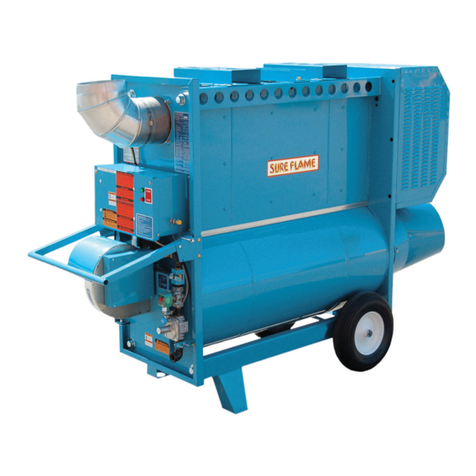
Sure Flame
Sure Flame IX405 User manual
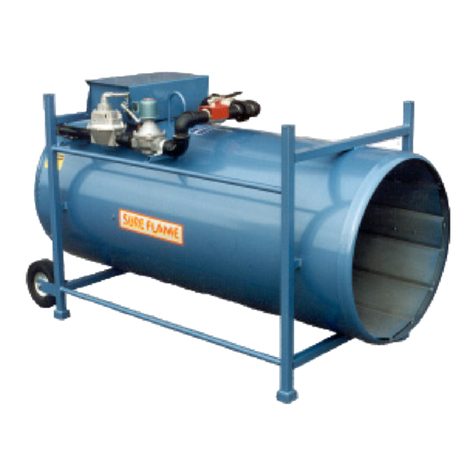
Sure Flame
Sure Flame SL11E User manual

Sure Flame
Sure Flame ID400 User manual

Sure Flame
Sure Flame IX800 User manual
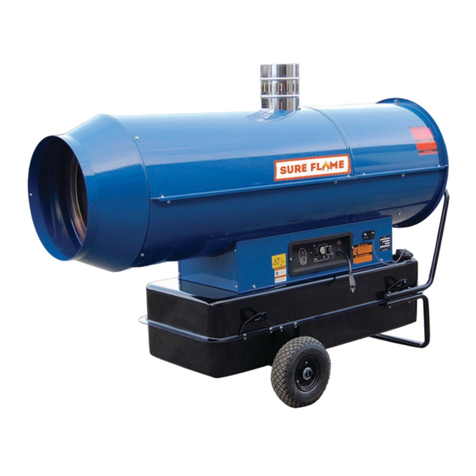
Sure Flame
Sure Flame ID 100 User manual
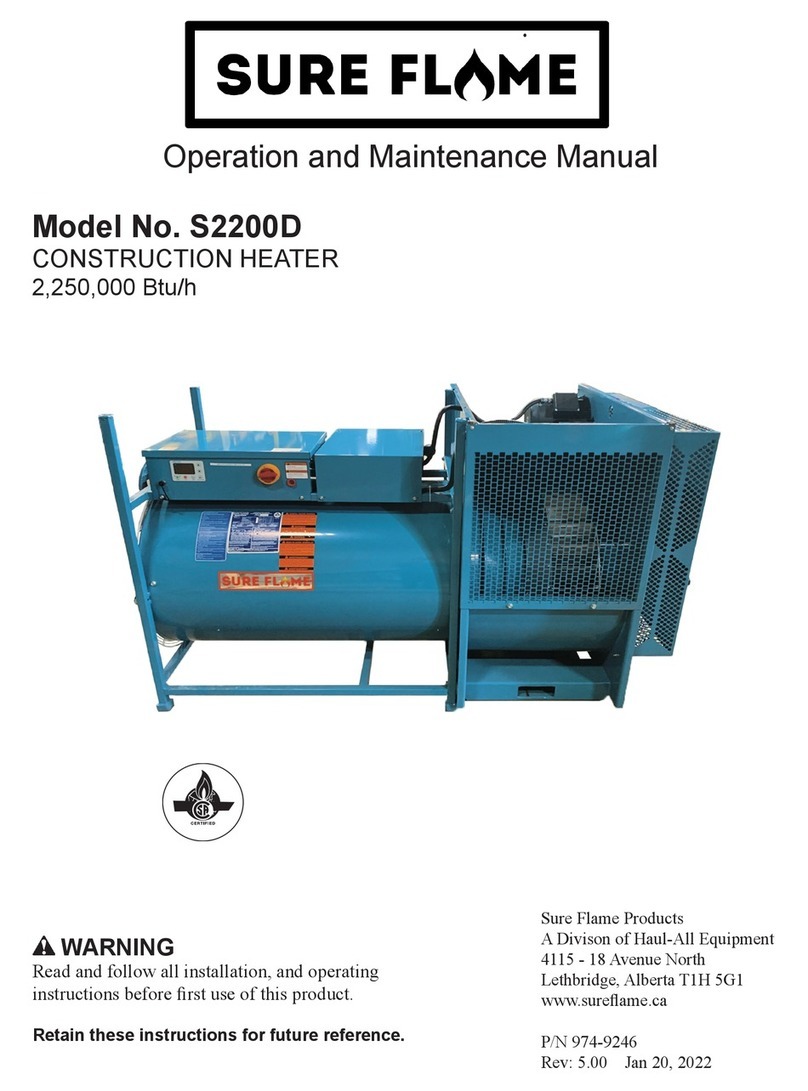
Sure Flame
Sure Flame S2200D User manual

Sure Flame
Sure Flame S2200D User manual

Sure Flame
Sure Flame SE405 Installation and user guide
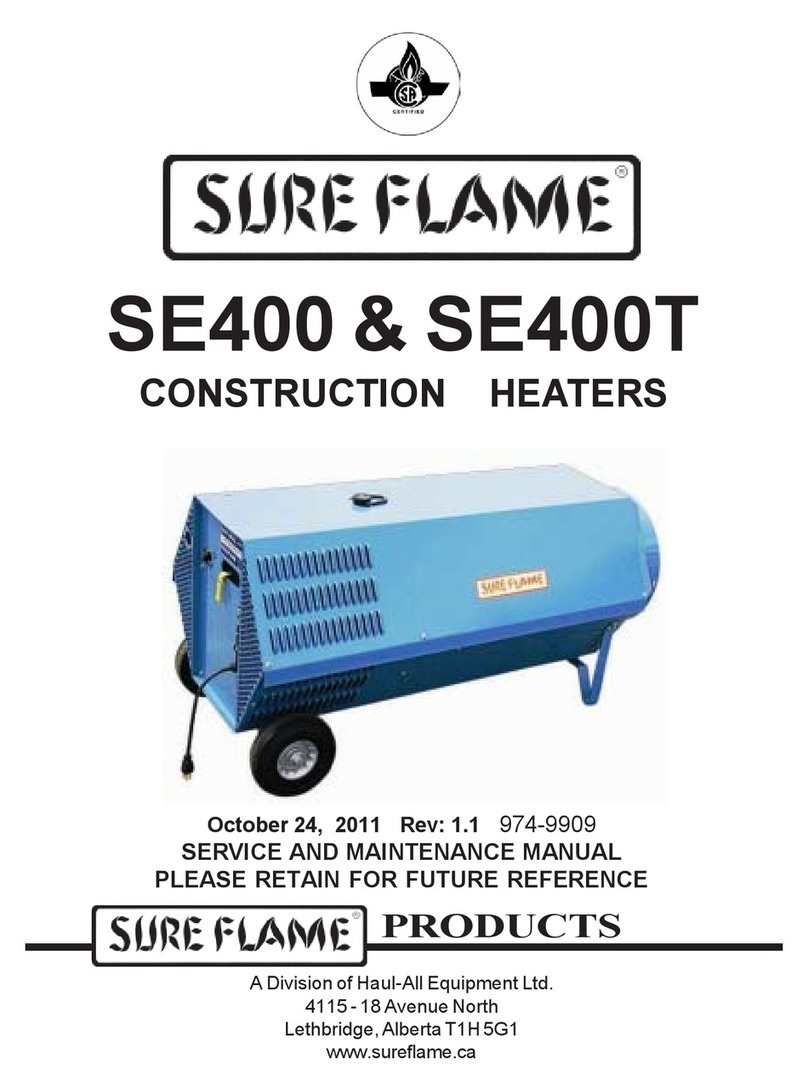
Sure Flame
Sure Flame SE400 User manual
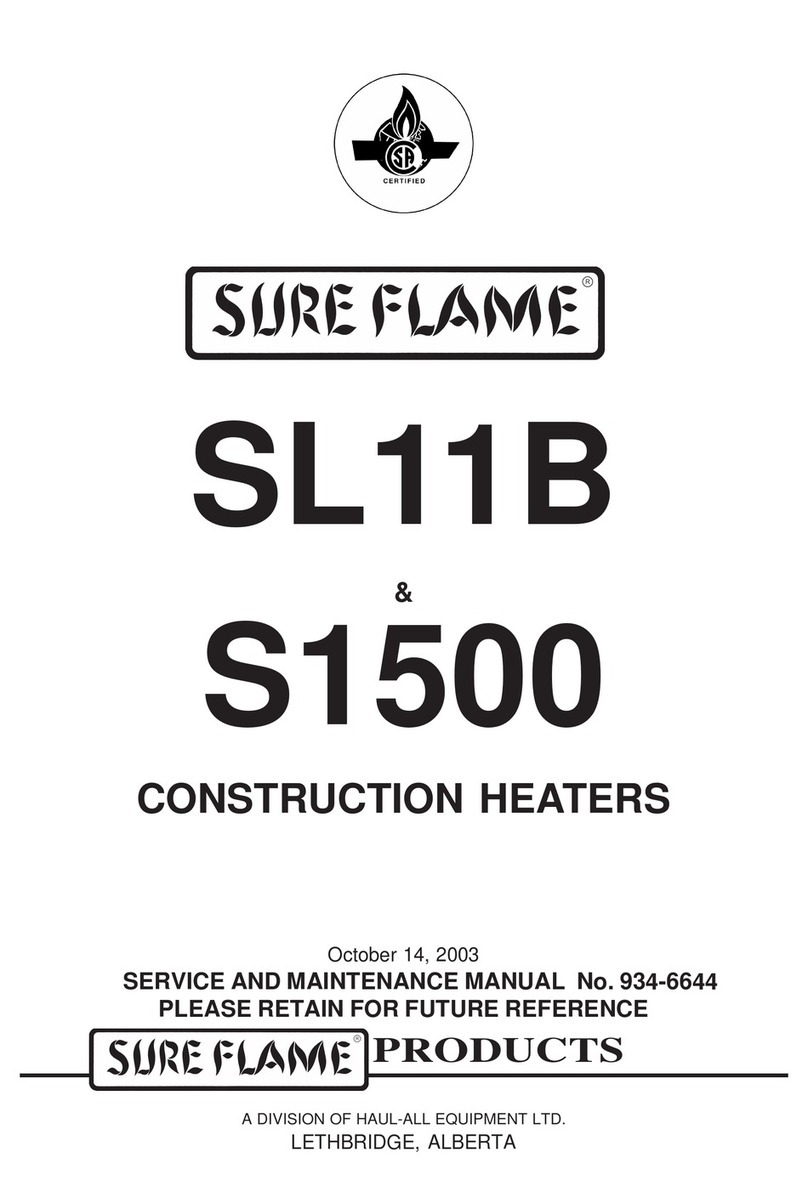
Sure Flame
Sure Flame SL11B Installation and user guide



